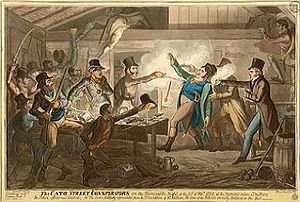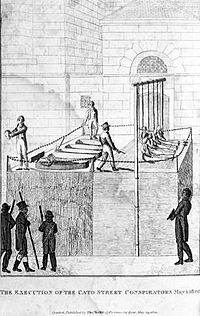Cato Street Conspiracy: Difference between revisions
ClueBot NG (talk | contribs) m Reverting possible vandalism by 91.90.97.125 to version by Catsmeat. False positive? Report it. Thanks, ClueBot NG. (1452642) (Bot) |
added Category:Assassination attempts using HotCat |
||
| Line 58: | Line 58: | ||
[[Category:Conspiracy]] |
[[Category:Conspiracy]] |
||
[[Category:Prime Ministers of the United Kingdom]] |
[[Category:Prime Ministers of the United Kingdom]] |
||
[[Category:Assassination attempts]] |
|||
[[fr:Complot de la Rue Cato]] |
[[fr:Complot de la Rue Cato]] |
||
Revision as of 13:20, 24 January 2013
This article needs additional citations for verification. (February 2012) |

The Cato Street Conspiracy was an attempt to murder all the British cabinet ministers and Prime Minister Lord Liverpool in 1820. The name comes from the meeting place near Edgware Road in London. The Cato Street Conspiracy is notable due to dissenting public opinions regarding the punishment of the conspirators. While some supported the high-ended attempts to ensure that the Spencean Philanthropists were found guilty, others remained conflicted due to the demand of parliamentary reform.[1]
Origins

The conspirators were called the Spencean Philanthropists, a group taking their name from the British radical speaker Thomas Spence. The group was known for being a revolutionary organization, involved in minor unrest and propaganda.
Some of them, particularly Arthur Thistlewood, had been involved with the Spa Fields riots in 1816. Thistlewood came to dominate the group with George Edwards as his second in command. Most of the members were angered by the Six Acts and the Peterloo Massacre, as well as with the economic and political depression of the time. They planned to assassinate a number of cabinet ministers, overthrow the government and establish a "Committee of Public Safety" to oversee a radical revolution, similar to the French Revolution. According to the prosecution at their trial, they had intended to form a provisional government headquartered in the Mansion House.
Governmental crisis

Industrialization in the early 1800s created serious social unrest, disrupting the peaceful agricultural society that the British were accustomed to. This evolution from rural to urban, and the complications that arose from it – such as inflation and shifts in employment needs – created an environment conducive to radicals like the Cato Street conspirators. The end of the Napoleonic Wars in 1815 further disturbed the delicate situation by returning job-seeking soldiers to the homeland.[2] Then, King George III's death on January 29, 1820, created a new governmental crisis. In a meeting held on February 22, one of the Spenceans, George Edwards, suggested that the group could exploit the political situation and kill all the cabinet ministers. They planned to invade a cabinet dinner at the home of Lord Harrowby, Lord President of the Council, armed with pistols and grenades. Thistlewood thought the act would trigger a massive uprising against the government. James Ings, a coffee shop keeper and former butcher, later announced that he would have decapitated all the cabinet members and taken two heads to exhibit on Westminster Bridge. Thistlewood spent the next hours trying to recruit more men for the attack. Twenty-seven men joined the effort.
Discovery

When Jamaican-born William Davidson, who had worked for Lord Harrowby, went to find more details about the cabinet dinner, a servant in Lord Harrowby's house told him that his master was not at home. When Davidson told this to Thistlewood, he refused to believe it and demanded that the operation commence at once. John Harrison rented a small house in Cato Street as the base of operations. However, George Edwards was working for the Home Office and had become an agent provocateur; in fact, some of the other members had suspected him but Thistlewood had made him his aide-de-camp. Edwards had presented the idea with the full knowledge of the Home Office, who had also put the advertisement about the supposed dinner in The New Times. When he reported that his would-be-comrades would be ready to follow his suggestion, the Home Office decided to act.
Arrest

On February 23, Richard Birnie, Bow Street magistrate, and George Ruthven, another police spy, went to wait at a public house on the other side of the street of the Cato Street building with 12 officers of the Bow Street Runners. Birnie and Ruthven waited for the afternoon because they had been promised reinforcements from the Coldstream Guards, under the command of Lieutenant FitzClarence, the late king's grandson. Thistlewood's group arrived during that time. At 7:30 pm, the Bow Street Runners decided to apprehend the conspirators themselves. In the resulting brawl, Thistlewood killed a police officer, Richard Smithers, with a sword. Some conspirators surrendered peacefully, while others resisted forcefully. William Davidson failed to fight his way out. Thistlewood, Robert Adams, John Brunt and John Harrison slipped out through the back window but they were arrested a few days later.
Charges
"1. Conspiring to devise plans to subvert the Constitution. 2. Conspiring to levy war, and subvert the Constitution. 3. Conspiring to murder divers of the Privy Council. 4. Providing arms to murder divers of the Privy Council. 5. Providing arms and ammunition to levy war and subvert the Constitution. 6. Conspiring to seize cannon, arms and ammunition to arm themselves, and to levy war and subvert the Constitution. 7. Conspiring to burn houses and barracks, and to provide combustibles for that purpose. 8. Preparing addresses, &c. containing incitements to the King's subjects to assist in levying war and subverting the Constitution. 9. Preparing an address to the King's subjects, containing therein that their tyrants were destroyed, &c., to incite them to assist in levying war, and in subverting the Constitution. 10. Assembling themselves with arms, with intent to murder divers of the Privy Council, and to levy war, and subvert the Constitution. 11. Levying war." [3]
Trial

During the trial, the defence argued that the statement of Edwards, a government spy, was unreliable and he was therefore never called to testify. Police persuaded two of the men, Robert Adams and John Monument, to testify against other conspirators in exchange for dropped charges. Most of the accused were sentenced to be hanged, drawn and quartered for high treason on April 28. All sentences were later commuted, at least in respect of this medieval form of execution, to hanging and beheading. The death sentences of Charles Cooper, Richard Bradburn, John Harrison, James Wilson and John Strange were commuted to transportation for life.
John Brunt, William Davidson, James Ings, Arthur Thistlewood and Richard Tidd were hanged at Newgate Prison on the morning of May 1, 1820 in front of a large crowd, with some paying as much as three guineas for a good vantage point, from the windows of houses overlooking the scaffold.[4] Infantry were stationed close-by, but out of sight of the crowd and two troops of Life Guards were present. Large banners had been prepared with a painted order to disperse. These would be displayed to the crowd if trouble caused the authorities to invoke the Riot Act.[4]
The hangman was John Foxton who was assisted by Thomas Cheshire in this high profile execution[5] After their bodies had hung for half an hour, they were lowered one at a time and an unknown individual in a black mask decapitated them with a small knife. Each beheading was accompanied by shouts, booing and hissing from the crowd. Each head was given to the assistant executioner in turn, who raised and displayed it to the assembled spectators and declaring it to be the head of a traitor before placing it in the coffin with the remainder of the body.[4]
Legacy
The British government used the incident to justify the Six Acts that had been passed two months prior. However, in the House of Commons, Matthew Wood MP accused the government of purposeful entrapment of the conspirators to smear the campaign for parliamentary reform. The otherwise pro-government newspaper The Observer ignored the order of the Lord Chief Justice Sir Charles Abbott not to report the trial before the sentencing.
The conspiracy is the subject of many books, as well as one play, Cato Street, written by the actor and author Robert Shaw. The conspiracy was also the basis for a 2001 radio drama, Betrayal: The Trial of William Davidson by Tanika Gupta, on BBC Radio 4.
Trivia
• In popular culture, there is a British punk rock band that takes its name from the Cato Street conspiracy.
See also
References
- ^ [1] The National Archives
- ^ [2] The National Archives
- ^ [3] Court Decision
- ^ a b c "Execution of Thistlewood and Other for High Treason". The Morning Chronicle. London. May 2, 1820.
{{cite news}}:|access-date=requires|url=(help); Unknown parameter|Issue=ignored (|issue=suggested) (help) - ^ [4] Newgate Prison on the Capital Punishment website
External links and other sources
- A Web of English History
- Black Presence in Britain about the conspiracy
- Spartacus Schoolnet about the Conspiracy
- The text of the court decision
- An authentic history of the Cato-Street Conspiracy by George Theodore Wilkinson
